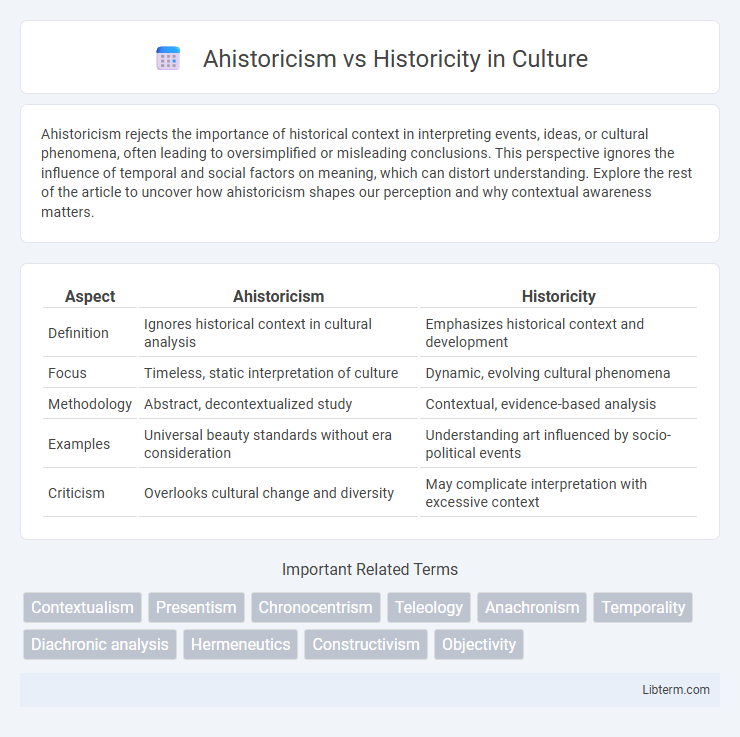Ahistoricism rejects the importance of historical context in interpreting events, ideas, or cultural phenomena, often leading to oversimplified or misleading conclusions. This perspective ignores the influence of temporal and social factors on meaning, which can distort understanding. Explore the rest of the article to uncover how ahistoricism shapes our perception and why contextual awareness matters.
Table of Comparison
| Aspect | Ahistoricism | Historicity |
|---|---|---|
| Definition | Ignores historical context in cultural analysis | Emphasizes historical context and development |
| Focus | Timeless, static interpretation of culture | Dynamic, evolving cultural phenomena |
| Methodology | Abstract, decontextualized study | Contextual, evidence-based analysis |
| Examples | Universal beauty standards without era consideration | Understanding art influenced by socio-political events |
| Criticism | Overlooks cultural change and diversity | May complicate interpretation with excessive context |
Introduction to Ahistoricism and Historicity
Ahistoricism refers to the approach that disregards historical context and development, treating concepts or events as isolated from their temporal and cultural backgrounds. Historicity emphasizes the significance of historical conditions and processes in shaping ideas, phenomena, and social realities, grounding understanding in specific temporal contexts. These contrasting perspectives influence disciplines such as literature, philosophy, and social sciences by either neglecting or highlighting the role of history in interpretation and analysis.
Defining Ahistoricism: Key Concepts
Ahistoricism involves disregarding historical context and treating events or ideas as isolated from their time and cultural background, often leading to distorted interpretations. Key concepts include temporal decontextualization, where historical development is ignored, and ahistorical analysis that neglects the evolution and causality of phenomena. This approach contrasts with historicity, which emphasizes the significance of historical context in understanding meaning and existence.
Understanding Historicity: Core Principles
Historicity refers to the accuracy and authenticity of historical events based on evidence, emphasizing the importance of context, chronology, and cause-effect relationships in understanding the past. Core principles of historicity include critical analysis of sources, verification through corroboration, and awareness of bias or anachronism to ensure interpretations reflect true historical conditions. Unlike ahistoricism, which ignores historical context, historicity demands rigorous engagement with material, cultural, and social factors that shape historical narratives.
Historical Contexts: Origins and Development
Ahistoricism rejects the influence of historical contexts in interpreting events and ideas, treating them as isolated from time and cultural backgrounds. Historicity emphasizes the importance of understanding origins and development within specific historical contexts, recognizing that meaning and significance evolve over time. The debate between ahistoricism and historicity stems from differing views on whether history shapes knowledge or if timeless truths exist independently of temporal conditions.
Ahistoricism in Philosophy and Critical Theory
Ahistoricism in philosophy and critical theory refers to the tendency to interpret concepts, texts, or social phenomena without considering their historical context or development, often resulting in ahistorical or decontextualized analyses. This approach contrasts with historicity, which emphasizes the importance of historical context and temporal specificity in shaping meaning and understanding. Ahistoricism can lead to an underestimation of the influence of historical forces and structures, limiting the depth of critical inquiry and theoretical analysis.
The Role of Historicity in Historiography
Historicity plays a crucial role in historiography by ensuring that historical events are analyzed within their specific temporal, cultural, and social contexts, allowing for a more accurate and nuanced understanding of the past. Unlike ahistoricism, which overlooks the significance of historical context and interprets events in isolation, historicity emphasizes the importance of time-bound circumstances and evolving human experiences. This approach helps historians avoid anachronistic interpretations and supports the construction of a coherent narrative grounded in authentic historical evidence.
Contrasting Worldviews: Ahistoricism vs Historicity
Ahistoricism rejects the significance of historical context, treating events and ideas as isolated from temporal and cultural influences, while historicity emphasizes the essential role of history in shaping meaning and understanding. Ahistoricism often leads to interpretations that overlook the evolution of concepts, whereas historicity insists on examining continuity, change, and the conditions that give rise to narratives. This contrast shapes disciplines such as philosophy, literature, and social sciences, determining whether phenomena are analyzed through timeless principles or context-dependent frameworks.
Implications for Cultural and Social Analysis
Ahistoricism neglects historical context, leading to superficial cultural and social analysis that overlooks the evolution of traditions, identities, and power structures. Historicity emphasizes the importance of temporal context, allowing researchers to understand how past events and processes shape present social dynamics and cultural meanings. This approach enables a deeper, more nuanced interpretation of societal changes, reinforcing the complexity of cultural phenomena within their historical frameworks.
Case Studies: Applications in Literature and Art
Case studies in literature and art illustrate ahistoricism through works that detach from specific historical contexts, emphasizing timeless themes or universal human experiences, often seen in modernist texts like T.S. Eliot's "The Waste Land." In contrast, historicity in art and literature is exemplified by pieces grounded in particular historical moments, such as Hilary Mantel's "Wolf Hall," which reconstructs Tudor England with rich historical detail, or Diego Rivera's murals that depict Mexican social and political history. These approaches shape interpretation, with ahistoricism inviting broader philosophical reflection, while historicity anchors meaning in concrete socio-political and cultural realities.
Contemporary Relevance and Future Perspectives
Ahistoricism, characterized by the disregard of historical context, limits understanding of contemporary social and cultural dynamics, while historicity emphasizes the importance of historical conditions in shaping current realities and informs more nuanced analyses. In contemporary discourse, historicity supports critical engagement with issues such as identity, memory, and power, fostering more informed policy-making and cultural preservation strategies. Future perspectives highlight the integration of historicity in digital humanities and artificial intelligence, enabling deeper insights through historical data analysis and ensuring ethical development aligned with historical awareness.
Ahistoricism Infographic

 libterm.com
libterm.com